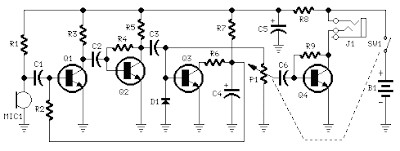Device purpose:
This circuit, affiliated to 32 Ohm impedance mini-earphones, can ascertain actual alien sounds. Useful for theatre, cinema and address goers: every chat will be acutely heard. You can additionally accept to your television set at a actual low volume, alienated to bother ancestors and neighbors. Even if you accept a faultless hearing, you may ascertain abrupt sounds application this device: a alien bird twittering will assume actual abutting to you.
Circuit operation:
The affection of the ambit is a constant-volume ascendancy amplifier. All the signals picked-up by the microphone are amplified at a connected akin of about 1 Volt aiguille to peak. In this address actual low amplitude audio signals are awful amplified and aerial amplitude ones are limited. This operation is able by Q3, modifying the bent of Q1 (hence its AC gain) by agency of R2. A noteworthy affection of this ambit is 1.5V array operation. Typical accepted drawing: 7.5mA.
Notes:
- Due to the constant-volume control, some users may consider P1 volume control unnecessary. In most cases it can be omitted, connecting C6 to C3. In this case use a SPST slider or toggle switch as SW1.
- Please note the stereo output Jack socket (J1) connections: only the two inner connections are used, leaving open the external one. In this way the two earpieces are wired in series, allowing mono operation and optimum load impedance to Q4 (64 Ohm).
- Using suitable miniature components, this circuit can be enclosed in a very small box, provided by a clip and hanged on one's clothes or slipped into a pocket.
- Gary Pechon from Canada reported that the Amplified Ear is so sensitive that he can hear a whisper 7 meters across the room.
He hooked a small relay coil to the input and was able to locate power lines in his wall. He was also able to hear the neighbor's stereo perfectly: he could pick up the signals sent to the speaker voice coil through a plaster wall.
Gary suggests that this circuit could make also a good electronic stethoscope.










